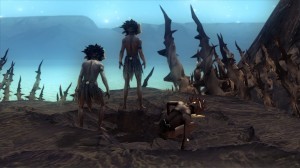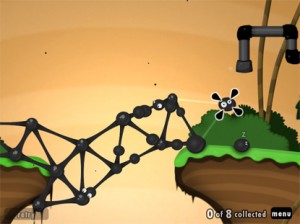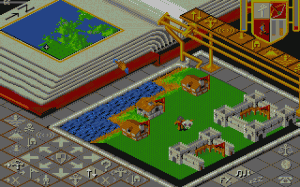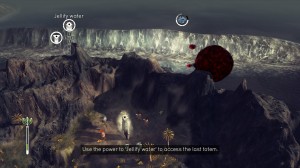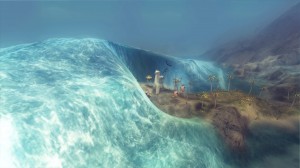What happens when you combine World of Goo, Lemmings, and Populous? You mean to tell me you’ve never heard of any of them? *Sigh* Well all right then, we’ll do this the hard way.
World of Goo is a puzzle game released in 2008 where you are given little goo balls, then have to connect them in such a way that the long chain / contraption of goo reaches the vacuum like device somewhere else on the map. When it does, any spare goo you haven’t used to build that contraption gets sucked into the vacuum and if you manage to suck enough goo in, you advance to the next level. It forces the player to build an efficient contraption as gravity and a limited amount of goo are against you at all times. It’s currently available for the PC, Mac, Wii (thru WiiWare), and some phone peripherals.
Lemmings requires us to go a little farther back, say to 1991. Lemmings was originally developed for the PC and Commodore Amiga, but has made its way to various consoles throughout the years. My first time playing it was on the SNES. The object was to get these walking, mindless creatures from point A to point B while saving as many as possible. You had a variety of skills the lemmings could use but most were for a limited time. Clicking on the builder skill, for example, then a lemming, would result in said lemming building a diagonal brick staircase for about twenty seconds. After that, it would continue forward and plunge itself right to its death. Lemmings, it turns out, don’t bounce.
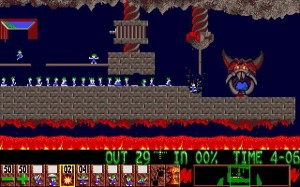
If you’re having an off day and are feeling particularly morbid, go ahead and try that nuke / explode all command.
Go further back still to 1989 and we have Populous, one of, if not the, first “god” game. It was first playable on the Amiga, Atari ST, and PC but later adapted to other consoles like the SNES. In Populous, you were a deity that controlled the land in an effort to get your civilization to prosper. You were often pitted against another deity with another civilization trying to do the same thing. Once said civilizations met, they’d fight. Every match I ever played usually involved me making high, flat land so I’d be able to prosper while constantly creating floods that destroyed everything on the layer closest to sea level. My opponent was usually wiped out after a few floods, whatever he had left was easily picked off by the uber knights that I created.
To sum them all up, World of Goo made use of physics and gravity forcing the player to think along those terms while Lemmings taught the player how best to use the environment and skills to get from one location to another. Populous made use of allowing the player to actually change the land itself by giving you the powers of a deity.
From Dust reminds me a little of all of them (Populous more so), except that in this game you control the environment and shape it as efficiently as possible to get your tribe to their next objective. The enemies in this game are the elements themselves. One map, you might have to figure out how to shape the land in such a way that prevents a tidal wave from washing your tribe out every six minutes. In another map, you might have to figure out how best to divert lava so that your tribe has a clear path to their goal.
Battling the elements is not an easy task, luckily you have powers that can be activated after a cooldown period that help you for a short time. One power, for example, extinguishes all fires on the map for a short time. When you make your way to maps with fire plants, be thankful that you have it.
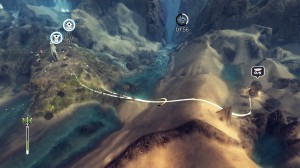
Your villages expand vegetation slowly around the map. Have enough vegetation on the map and you can unlock some extras. On the downside…fires and vegetation don’t mix.
You can’t control the tribe directly, though you can tell them where you’d like them to go. One of my gripes with the game is that sometimes the pathfinding is wonky. For example, I once told my tribe to go to the nearest totem and the path was relatively clear. However, there was a small puddle of water in their way so instead of getting their feet wet they just stopped to yell at me. Really? You can’t swim?
That said, From Dust is a beautiful game. On maps where I’m not forced to take action quickly, I sometimes catch myself sitting there and messing with the physics of the land, watching how one change would affect all of the other elements on the map. If you’re familiar with the concept of cause and effect and enjoy what if questions and scenarios, then you’d probably get a kick out of this puzzle game.
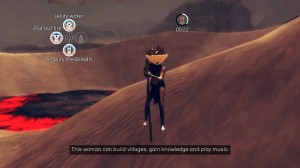
This woman’s back is to an active volcano and the countdown timer reads “22 seconds”. This can only end well.
It was released in 2011 and currently available for PC, XBox 360, and PS3. If you are interested and plan to go the PC route, check the PC system requirements of the game before purchasing!
Final Verdict: 8/10
—
You can see video play sessions here:
http://www.youtube.com/watch?v=B7ou1vZ1x_s
—

